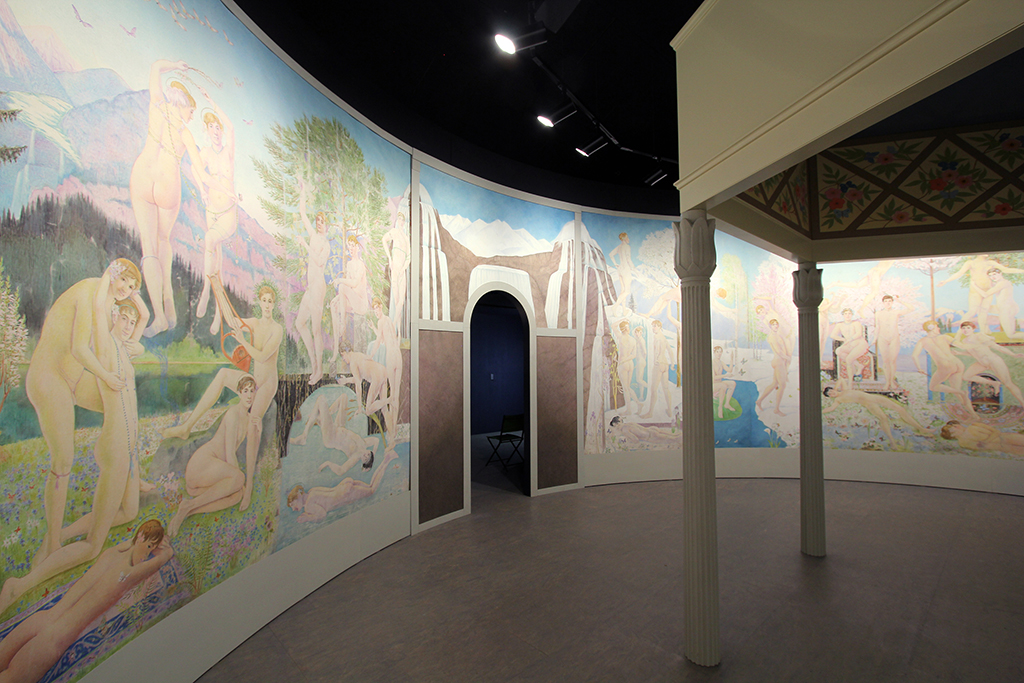LGBT pioneer’s spectacular painting returns to Monte Verità

After a lengthy restoration, visitors can once again admire the 26-metre circular painting Il Chiaro Mondo dei Beati [The clear world of the blessed] by Estonian artist and LGBT pioneer Elisàr von Kupffer (1872-1932) at the Monte Verità museum complex near Ascona, in southern Switzerland.
The polyptych depicts 84 male nude figures relaxing in idyllic scenery. It was produced in the region between 1920–1939 by Elisàr von Kupffer, a painter, poet, historian and playwright from Tallinn, Estonia, who has over the decades become an LGBT icon. It was rediscovered by legendary art historian and curator Harald Szeemann in the late 1970s, and has been renovated several times. Today, it sits in the Elisarion Pavilion on Monte Verità, the hill that overlooks the resort of Ascona on Lake Maggiore.
The verdant hill in Italian-speaking Switzerland has always had a unique pulling power. In the early 20th century it became known as an alternative vegetarian colony, attracting artists, anarchists and intellectuals from around Europe. A small art centre was built on the Ascona hill in the early 1920s; later it became a hotel and seminar centre. Today, Monte Verità is a modern congress and cultural centre spread over seven hectares, run by a foundation of the same name.

Gay paradise
Von Kupffer’s circular 26-metre-long polyptych is made up of 16 canvases. It presents the artist’s ideal of a gay paradise, with 84 young male nudes relaxing in idyllic scenery. It includes glaciers, coastlines, flower-covered meadows and mountain lakes. The human figures appear in 33 different scenes, which the author describes in verse.
“It’s a timeless work. It is unique. There is nothing like it,” says art historian David Streiff, former head of the Federal Office of Culture and who oversaw the latest restoration.

Von Kupffer founded Klarismus (Clarity), a philosophical-religious movement oriented towards social and sexual emancipation, together with German philosopher and writer Eduard von Mayer (1873-1960). The two men met in 1891 and became lifelong partners from 1897. Klarismus (Clarity), like Helena Blavatsky’s theosophy or Rudolf Steiner’s anthroposophy, was a movement created as a reaction to positivism and scientific worldviews, as well as to the predominant moral ideas of the time.
“A very interesting iconography emerged from Klarismus (Clarity), which leads you from darkness to light and takes in many aspects of European art history, including religious ones, to create something extraordinary,” says Streiff.
Spreading Clarity around the world
After travelling around Europe, the couple arrived in canton Ticino in 1915. Their plan was to spread their ideas from the Locarno district of Minusio, where they lived, to the rest of the world. “At the time, he and his partner were trying to live in Ticino as a creative homosexual couple. This was quite extraordinary in a Catholic canton,” says Streiff. Elisàr von Kupffer was one of the pioneers of the LGBT movement, he adds.

Back in 1925, von Kupffer and von Mayer built the Sanctuarium Artis Elisarion in Minusio to house the circular painting. It was installed in an annex at the end of a pathway aimed at leading visitors from the “Chaotic World” to the “Clear World”.
Upon their death, the painting – together with the sanctuary – was donated to the Municipality of Minusio. The polyptych was removed from its original location in 1977 for a refurbishment and was later rediscovered by Szeemann.
He included it in his traveling exhibition “Monte Verità – the breasts of truth” dedicated to the history of the unique community from the region. Following his exhibition – which was shown in Zurich, Berlin, Vienna and Munich – a permanent location was found for the painting at the Casa Anatta in Ascona. He had a wooden pavilion built to house the painting, but it remained inaccessible for years.
“When Szeemann died in 2005, it was clear to me that it was now up to others to look after Elisarion’s legacy [von Kupffer’s pseudonym],” says Streiff.
At the time his painting was in a poor state. Streiff has helped raise funds for the project and has found huge support from Switzerland’s gay community, of which he himself is a part.

Extensive restoration
The painting, which is overseen by canton Ticino’s cultural heritage office, has since been restored. The work was financed by the Monte Verità Foundation and the Pro Elisarion Association, founded in 2008 preserve the works of Elisàr von Kupffer and Eduard von Mayer.
“Restoring the painting was not easy because the material was badly damaged and the canvases had folds. A small part of the painting was completely missing and had to be redone,” explains Christian Marty, who was in charge of the restoration with his partner Petra Helm.
Both are internationally recognised specialists in landscape painting restoration. In Switzerland they are well-known for bringing the Bourbaki PanoramaExternal link, exhibited in Lucerne, back to life. The 112-metre circular painting by Edouard Castres portrays the internment of 87,000 French soldiers who fled to Switzerland during to winter of 1871.
But it’s not just von Kupffer’s painting that has been restored. The entire pavilion that houses the work has been renovated and new visitor panels have been installed. Visitors can also see a film about von Kupffer and some of his other paintings are also on show.
Translated from German by Simon Bradley
The Monte Verità museum complex, near Ascona in canton Ticino, is open from April 1-November 1. It includes the following exhibitions:
- the Casa Anatta Museum, which houses the historic exhibition “Monte Verità. Le mammelle della verità” by Harald Szeemann and “Le verità di una montagna” by Andreas Schwab;
- the Casa Selma “air-light hut”, built in 1904 by the first settlers, where it is possible to see a film on the history of Monte Verità;
- the House of the Russians (Casa dei russi), whose name pays tribute to the presence of numerous Russian students at Monte Verità after 1910. Today it houses temporary exhibitions;
- the Elisarion Pavilion, which houses the work “Il Chiaro Mondo dei Beati” (1920-1939) by Elisàr von Kupffer.

More
Searching for truth on Monte Verità
A previous version of this story referred to the artist’s hometown as Riga, Estonia. It is in fact Tallinn, Estonia, and has been corrected in this version.

In compliance with the JTI standards
More: SWI swissinfo.ch certified by the Journalism Trust Initiative










Join the conversation!